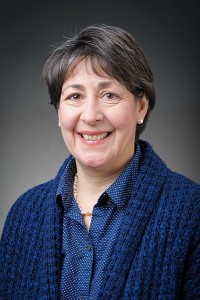Defining accessibility in Madison
Posted by millis2 on Wednesday, December 16, 2015 · Leave a Comment
by Sandra Kinzer
You might think there’s enough parking in downtown Madison. Though street parking is sparse, there are multiple ramps for visitors and workers to use. But parking ramps aren’t so easy to use if you can’t get past the gate.
That’s the problem that Nick Zouski runs into anytime he needs to find parking downtown. Due to his disability, he can’t get out of his car to reach the button and take the ticket for the gate to open. So he opts for surface parking, which is sometimes hard to find.

Cathy Trueba is director of the McBurney Disability Resource Center at UW-Madison. (Bryce Richter/UW-Madison)
“Madison does pretty well accessibility-wise,” said Zouski. “I can’t think of any important services that I can’t access. (But) parking downtown is atrocious.”
Zouski works for Access to Independence, which helps people with disabilities find resources and funding.
He’s a quadriplegic as a result of diving accident, which means he can’t move his arms or legs. He said his disability impacts his personal life, including personal care, more than his work life.
“The happiest I am in my job is when I am talking to a newly injured person,” he said.“I can help them see what I saw, help them see that there are options beyond sitting home and watching TV the rest of their lives.” Zouski still hunts and fishes as he did before he was injured.
Madison is a fairly accessible place for people with physical disabilities to live. Many of the resources used nationally for the disabled were developed and created here, according to Jason Glozier, Disability Rights and Services program coordinator for the City of Madison.
However, there are still issues both with funding and public perception. Because physical disabilities are the most visible types of disabilities, many types of non-physical disabilities are often overlooked. Most people with disabilities at University of Wisconsin–Madison, and in the world, have non-apparent disabilities, noted Cathy Trueba, director of UW-Madison’s McBurney Disability Resource Center.
“We’re really working to undo that stereotype around disabilities that unless you have an appliance, or a dog, or a hearing aid, or an interpreter, you don’t have a disability,” Trueba said. “This is an obvious visible segment of the community, but is by no means how we think about accessibility or disability in a contemporary fashion.”
For many people that come in to talk to Zouski, the problem is finding funding for someone to help take care of them and finding a long term care solution.
A more widespread but less visible issue that he hears about is employment.
“No one would ever come out and say ‘Yeah it was a great interview; you’re not gonna get the job because you’re disabled.’ No one would ever say that, but I mean I’ve been after this for a while, and I know it happens, all the time,” he said. “I call it invisible discrimination.”
The state employment rate for people with physical disabilities is fairly low, according to Anna Gouker, an employment counselor from Employment Resources Inc. She works to increase those numbers by helping people find resources.
She herself has a disability, spinal muscular atrophy, which means she needs a wheelchair and a squadron of nurses.
“It gets complicated,” she said. She has to manage her nurses while also managing her job as a counselor. She also gets frustrated trying to master the technology of her wheelchair.
Overall, Gouker thinks Madison is accessible.
“I think that public perceptions of disability can be far more limiting than the conditions themselves,” she said. “The way people view you and the assumptions they have about you, based on … what they saw in a movie or maybe just one encounter they had with someone.”
She’s not bullied; it’s almost the opposite. Oftentimes people won’t acknowledge her, because they don’t know what’s appropriate or because they are nervous, she suspects.
Glozier noted that non-disabled people often “don’t think about accessibility as a need, until they need extra access (for themselves).”
Instead of accessibility, “we talk more about usability and universal design now, in terms of creating environments which are usable to the most people,”said Glozier.
Perhaps the most visible example of this is curb cuts, ramps down to the street at crosswalks. Another example is a specific kind of door handle that can be used in a greater number of ways, noted Trueba. She also mentioned closed captioning on videos.
Trueba said the people who get the most caught up in accessibility are those who develop a disability later in life. “They say ‘Holy cow, I can’t believe how inaccessible our fill-in-the-blank is.’”
She said everyone “through accident, or injury through the normal aging process, ages into the community of people with disabilities. You have to.”
Category: Madison Problems, Social Justice · Tags: Disabilities, Sandra Kinzer
The arc of the moral universe is long, but it bends toward justice.
-Martin Luther King Jr.
 The Arc: Visions of justice
The Arc: Visions of justice